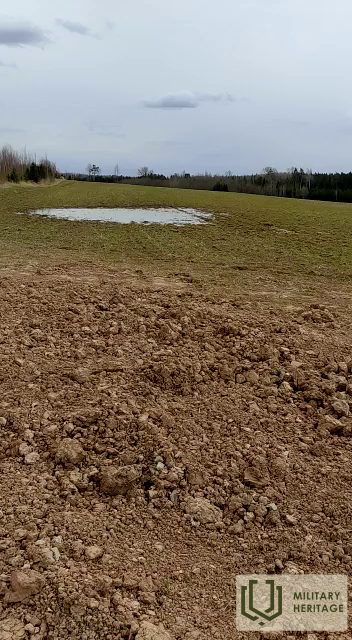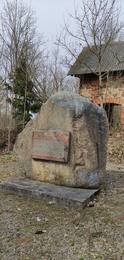Mūšiai Kaulačių dvare 1945 m. kovą
1945 m. netoli Kaulačio pusdvaro buvo Raudonosios armijos stebėjimo postas. Liudininkai prisimena, kad kovos prasidėjo 1945 m. kovą. Tai ne pirmas kartas, kai šiame lauke randami Antrojo pasaulinio karo laikų kapai.
Remtės valsčiuje, Brocėnų savivaldybėje, netoli „Kaulačių“ namų, 2021 m. buvo atkasti 23 vokiečių kareivių pelenai. Kadaise ten buvo to paties pavadinimo dvaras, o 1945 m. jame buvo įsikūręs Raudonosios armijos stebėjimo postas.
Liudininkai prisiminė, kad kovos prasidėjo 1945 m. kovą. Krito minos, žvangėjo kulkosvaidžiai, dundėjo patrankos, civiliai atsidūrė tarp dviejų fronto linijų netoli Pilsblīdenės. Po kovų aštuoni artimiausi namai, įskaitant „Kaulačių“ dvarą, aplinkui degė kaip dideli gaisrai.
Po karo žuvę vokiečių kareiviai ir latvių legionieriai buvo palikti lauke. Raudonoji armija surinko savo kritusius. Kiekvienas šeimininkas laidojo žuvusiuosius, kaip galėjo, nes sovietų valdžia buvo nurodžiusi, kad žuvusiuosius reikia laidoti. Priešingu atveju, vietovėje plistų įvairios ligos.
Šiame lauke ne pirmą kartą randami Antrojo pasaulinio karo laikų palaidojimai. Kasinėjimų metu aptikta, kad į tranšėją po kareiviais taip pat buvo įmesti keturi šautuvai, šalmas ir kareivio katilo dangtis su iškaltais iš dalies įskaitomais inicialais. Į paviršių taip pat buvo iškelta kelios vokiškos monetos, dujokaukės ryšulys ir drabužių likučiai.
https://skaties.lv/zinas/latvija/sabiedriba/remtes-pagasta-atrod-bez-vests-pazudusus-karavirus/
Susijusi laiko juosta
Susijusios temos
Susijusios vietos
Paminklas 8-ajam Raudonosios armijos Estijos šaulių korpusui
Paminklas 8-ojo Raudonosios armijos Estijos šaulių korpuso kariams yra Kaulači pusės dvaro ūkinio namo griuvėsiuose, apie 100 metrų į pietvakarius nuo kelio.
1945 m. kovo 17 d. prasidėjo paskutinis Raudonosios armijos puolimas Kurše. 8-ojo Estijos šaulių korpuso 7-osios Estijos šaulių divizijos užduotis buvo pasiekti Rygos–Liepojos geležinkelio liniją į vakarus nuo Blidenės stoties ir užtikrinti 3-iojo gvardijos mechanizuotojo korpuso ataką Gaikų kryptimi. Kovo 17 d. vakare 354-asis šaulių pulkas pasiekė geležinkelį į pietus nuo Kaulačų pusdvaro per mišką ir tęsė atakas šiaurės vakarų kryptimi, pasiekdamas Pikulių namus. Kaulačų pusdvaryje ir toliau į šiaurės rytus buvo vokiečių Burg-Stellung pozicijos, kurias gynė atskiri 329-osios pėstininkų divizijos daliniai. Visą kovo 18 d. dieną 354-ojo šaulių pulko atakos tęsėsi nesėkmingai.
Kovo 18 d. vakare 354-ąjį šaulių pulką pakeitė 27-asis šaulių pulkas. Puolimui taip pat turėjo būti panaudotas 3-iojo gvardijos mechanizuotojo korpuso 7-osios mechanizuotosios brigados, 1-ojo motorizuotojo bataliono, priešakinis dalinys su viena tankų kuopa. Iki kovo 19 d. vakaro sutelkto puolimo metu sovietai užėmė Kaulačio pusdvarį, užimdami dalį vokiečių pastatytos gynybinės linijos dominuojančioje aukštumoje.
Iki 1945 m. kovo pabaigos 8-ojo Estijos šaulių korpuso ir 3-iojo mechanizuotojo korpuso atakos Vikstraujtės ir Remtės kryptimis tęsėsi, tačiau nesėkmingos.
Kovų metu Kaulačių pusrūmyje buvo įsikūrusios įvairios būstinės, o 1975 m. gegužės mėn. šioje vietoje buvo atidengtas atminimo akmuo.






